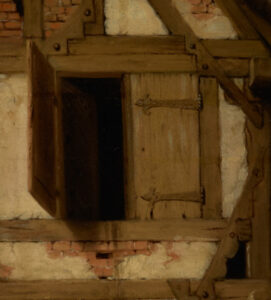Making Sauerkraut
With My Father

Mr. Nathan Runde

When people think of father-son time, they often think of fishing, hunting, or building a shed, but most wouldn’t think of making sauerkraut. Well, my dad isn’t like most, and that’s exactly what he, my baby son, and I did recently. We pulled out the sauerkraut pounder, the cabbage shredder, and the pickling salt, and off to work we went. Dad held baby Joseph, and guided me in the art of sauerkraut, inserting curious comments as we went. If you’re harvesting a prolific cabbage crop right about now, this will be a good art for you to learn too. Here is the tried and true method that he taught me.
After the sauerkraut was all prepared and Joseph was ready for a nap, Dad handed me the crock and smiled, “Now you’ll be doing this all the time!” he proclaimed. As I carried the kraut to my car, I thought, “This was a sweet and sauer experience.” Dad likes dumb jokes; he would be proud. And, honestly, I think he’s right — I will be doing this all the time. I hope you will too.
— Nathan
What You Need

Equipment:
• A large mixing bowl
• A clean five-gallon bucket
• A pickling crock or a large glass jar
• Sauerkraut pounder (I use a clean cut-off handle from an old pitchfork)
• If using a crock: A plate or lid that fits inside without a lot room around the edges; this holds the sauerkraut beneath the brine
• If using a jar: a standard bread bag filled with water, also to hold the sauerkraut beneath the brine
• A sharp knife or a cabbage shredder
Ingredients:
• 1 Large head of fresh cabbage; four to five pounds
• 1 Tablespoon of pickling or canning salt (or you can use kosher salt, but preferably not iodized kitchen salt, as it might interfere with the fermentation)
What You Do



Shred the cabbage: Remove any brown outer leaves from your cabbage and quarter it around the core. Using the knife or cabbage shredder, shred the cabbage into the bowl one quarter at a time; if using the shredder, press lightly to make fine strips.
Salt the cabbage: Sprinkle half the tablespoon of salt on top of the shredded cabbage. Then, with your hands, pull a few handfuls of cabbage from the bottom of the bowl, and set them on top. Sprinkle this with another half tablespoon of salt. Allow the salted cabbage to sit for about ten minutes. This will allow the salt to begin pulling water from the cabbage, forming a brine.
Pound the cabbage: Move the salted cabbage and any brine into the clean five-gallon bucket. Using your sauerkraut pounder, press down on the cabbage until a thin layer of brine covers all of the cabbage. This will take two or three minutes of pressing hard.
Transfer the cabbage: Move the salted cabbage into the crock or jar with your hands. Be sure to pour along the brine that has been squeezed out in the bucket. Press the cabbage down with your sauerkraut pounder so that it is below the surface of the brine. (If you are in a hurry, you can mix, salt, and pound the cabbage directly in the crock or jar.)
Cover the cabbage: If you are using a crock, place the lid or plate on top of the cabbage so that it keeps all the cabbage below the surface of the brine. Weigh this down with two glass jars. If you are putting your sauerkraut in a jar, fill the bread bag with water, and set this on top of the cabbage. This will form a water seal so that no sauerkraut can float up, and it will protect the sauerkraut from mold.
Ferment the cabbage: Take your crock or jar of cabbage to a place between sixty and seventy degrees; a basement is normally a good spot. Below sixty degrees, the fermenting process will go much slower; over seventy degrees, the sauerkraut could become mushy. Cover the crock or jar with a towel to prevent dust and spiders from sneaking in, and then let it sit.
The fermenting process varies in length, but it normally takes about three weeks to complete. The best way to know if your sauerkraut is done is to steal a few nibbles every couple days. Once you like how it tastes, it’s done!
Sometimes a bit of mold or yeast can form on the top of your sauerkraut. You will need to check on your sauerkraut every day to make sure no mold is forming. If there is a little mold, scoop it off and the sauerkraut should still be fine. You should throw away your batch if: the mold gets into the sauerkraut itself, the sauerkraut turns pink, the sauerkraut is mushy or slimy, or if the sauerkraut smells bad.
Storing:
After the fermentation process, the sauerkraut will be ready to eat! Put any that you don’t eat right away in some jars with lids, and move it to the fridge; it can be stored in the fridge for many months. You can also can your sauerkraut!
Some Kraut Wisdom From Dad
“Check your sauerkraut every day when it’s fermenting. Sometimes mold or yeast can form on the top. If you see this, scoop it off. The sauerkraut underneath should be fine.”
“You want everything you use to make sauerkraut to be clean.”
“Most people take out the core of the cabbage, I leave it because it tastes great. Plus it makes a nice crunchy snack when you’re making sauerkraut and when you’re checking it.”
“I love going downstairs and stealing pieces of sauerkraut while I check on it.”
“A lot of old-timers don’t even measure how much salt they put on, they just sprinkle some on and call it good. Just don’t put too much.”
“A friend of mine told me that his grandpa’s father made him drink sauerkraut juice every day during the Flu of 1918 to stay healthy.”
“No metal should touch your brine or sauerkraut; it messes up the fermentation.”
“If you forget about your sauerkraut and it starts to smell bad, it might be best to just throw it out.”
“Watch your fingers on the cabbage slicer. Every time I’ve made sauerkraut with Jim, he’s cut himself.”



















